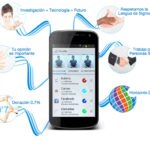"Existing technologies enable us to offer new solutions tailored to the user's environment" Interview with Visualfy
The winner of the G5 Innova awards was announced last week. There, national companies with new ideas seek to find a niche and offer solutions and responses to everyday problems and situations. The winner this time has been Visualfy. An app that wants to bring visual notifications to the cell phones of deaf people. An app that is already available for Android and, thanks to awards like these, will help these companies to continue growing and go international.

How was Visualfy born? Whose idea was it to develop an app aimed at deaf people?
Visualfy is the brainchild of Fusió d’Arts Technology S.L., a company that creates apps, websites and business management programs. Fusió d’Arts has been working with deaf people for more than seven years and we have extensive knowledge of this community, since we deal with them almost daily. We realized that they still have many unresolved needs and that through ICT and the Internet of Things we could offer them completely accessible solutions that enhance their quality of life. This is how Visualfy was born. (Visual Notify)
We live in a context where cell phone screens are becoming increasingly ubiquitous and, by extension, so is everything that has to do with seeing, and not so much looking. What challenges have you had with the development of smartphones in recent years? Do you think that there is a lack of apps optimized for this segment?
Being visual does not mean being accessible. The development of smartphones has been positive for these communities, since now it is possible to make low-cost video calls or use apps like Whatsapp. This is way smartphones are a fundamental tool for deaf people. The lack of apps adapted to any means of communication is obvious. Many can be read or listened to, but very few are concerned about the accessibility of people who use sign language as a means of communication. According to the World Federation of the Deaf, more than 70 million people in the world use sign language as a means of communication. This is why our solutions are adapted to any type of deafness and any means of communication, whether subtitles, audio or sign language.

Is there a niche and are there possibilities for innovating and growing when it comes to creating different interfaces?
Everything is improvable, so there is a niche for creating new interfaces offering greater usability and complete accessibility. But not only for that. Also for creating hardware that enables new solutions to be given to existing problems that, through the Internet of Things,
help to adapt homes, public buildings or private enterprises.
What difficulties and opportunities have you encountered with today's mobile platforms?
For now we have only worked with the Android operating system for several reasons. There are more smartphones on the market using this operating system, Android smartphones are available at very varied price ranges and the accessibility restrictions in IOS7 did not enable us to develop for iPhone. Now, with the new IOS8, all this has changed, so we can now start developing for iPhone.
Do you think that your model is a scalable solution for other devices?
In the second stage of the project we are developing what we call the Deaf Smart Space. This device will communicate via the Internet of Things with any household appliance and will send us its information totally adapted to any mean of communication.
Right now, what is your present as a company and what will your next steps be?
We are now improving the MVP and preparing the Deaf Smart Space prototype to be able to validate it with our users. This will take us until September. Once it has been validated we intend to close the first round of investment to enable us to globalize the project, since we now have downloads in 129 countries.
Do you think that the major cell phone manufacturers are not paying sufficient attention to the accessibility of people with disabilities?
They are becoming increasingly concerned about these issues, but there is still some way to go. At Visualfy we do not want to focus on mobile devices only. Existing technologies enable us to offer new solutions adapted to the user's environment, and this is what we want to focus on, on being able to offer completely accessible services.
You recently won the G5 Innova award. Do you think it will help you grow as a company?
We have received various awards and recognitions over the last twelve months. They all motivate us to keep going and also, some of them, like the G5 Innova awards, also help us financially and enable us to achieve new milestones within the project. Any recognition is good, not only in terms of personal self-fulfillment, but also because by going through several experts we confirm that we are on the right track and that things are being done correctly.